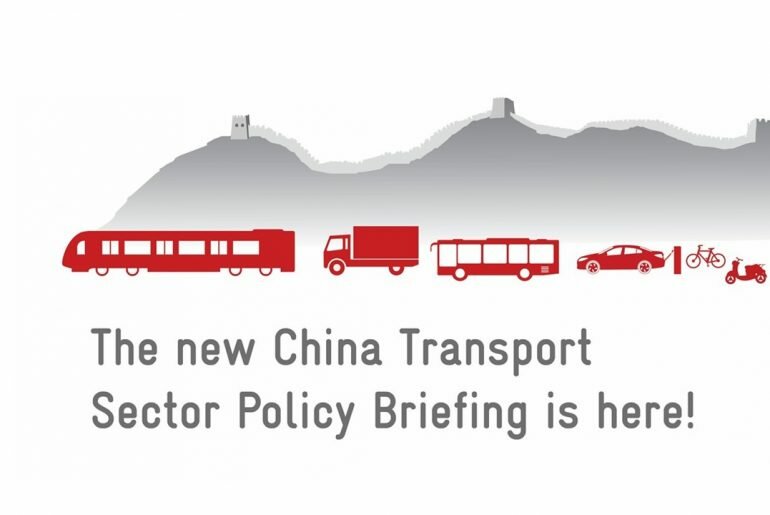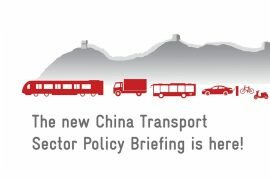China Transport Sector Policy Briefing – August, September 2018

The August/September edition of our China Transport Sector Policy Briefing is here! The Sustainable Transport Team at GIZ in China provides you with a monthly summary of new important policies in China’s transport sector.
Please click here to download: China Transport Sector Policy Briefing August, September 2018
In August and September, the Three-Year Blue Sky Action Plan has been refined for the city of Beijing as well as for the aviation sector. The safety of new energy vehicles (NEVs), pollution in maritime transport, testing of intelligent and connected vehicles (ICVs), as well as financing of sustainable transport were high on the agenda these two months.
NEV safety, subsidies, phasing out of sales of conventionally fueled vehicles in Hainan, reducing the impact of transport on pollution, ICV testing
Beijing intends to reduce total emissions in the transport sector by 30% until 2020 (compared to 2017). NEVs are to play a key role in the future. The Action Plan sets the target to reach a market volume of 400,000 NEVs in Beijing by 2020, and a rail freight transport volume increase of 10% between 2017 and 2020. By 2020, post, express delivery, and lightweight sanitation vehicles (under 4.5 tons) should be mostly fueled by alternative energies. Lightweight logistics vehicles with special traffic permits (under 4.5 tons), traditional buses in the city centre and its sub-centre in Tongzhou (Beijing’s second administrative seat) should be fully fueled by alternative energies.
Shenzhen, one of China’s growth powerhouses and leading NEV city continues electrification in the transport sector. A new draft policy stipulates new subsidy standards for the procurement of different kinds of NEVs. Shenzhen is already about to cut subsidies for new energy passenger vehicles and fully-electric buses and might be the test case for post 2020 (phase-out of NEV subsidies). Subsidies for NEVs registered between February and June 2018 have decreased by 30%; subsidies for pure electric trucks and utility vehicles decreased by 60%. Contrary to that, subsidies for fuel cell vehicles held constant which shows that China will continue to promote hydrogen electric vehicles. As always, Shenzhen’s policies are inclusive and it also includes subsidy standards for charging infrastructure. DC charging equipment is subsidized with 600 RMB/kW (approx. 76 EUR/kW) of installed power rate, while AC charging equipment above 40kW and below 40kW is subsidized with 300 RMB/kW (approx. 38 EUR/ kW) and 200 RMB/kW (approx. 25 EUR/kW) respectively. Lastly, NEV manufacturers have to establish a specialized fund for battery recycling, into which they pay 20 RMB for each kW of NEV battery power rate.
Hainan Island, which is called the Mallorca for Chinese, issued a Plan that aims at promoting green travel and 100% clean energy utilization in Hainan’s transport sector by 2030. Pure battery vehicles are envisioned as the main vehicles in public and private transport. The plan also stipulates a rate of vehicles to charging piles of less than 3:1 by 2020. By 2025, the rate of vehicles to charging piles and the rate of vehicles to public charging piles should be less than 2:1 and 7:1 respectively, the distances between charging service areas on highways should be less than 50 km. By 2025, Hainan Province should draw up a timeline for the prohibition on sales of conventionally fueled vehicles.
At the same time the Aviation Sector also sets out on a path towards electrification. The Implementation Plan by CAAC (Civil Aviation Administration of China) intends that all 40 airports in the key regions of Beijing-Tianjin-Hebei (Jing-Jin-Ji), the Yangtze River Delta as well as the Fen-Wei Plains in Shaanxi and Shanxi Province procure airport equipment and vehicles fueled with new energy. In addition, 50% of newly procured or upgraded vehicles at other important airports beyond the key regions with an annual service capacity of over 5 million passengers, must be NEVs or low emission vehicles. Fire engines, ambulances, as well as deicing and fueling equipment are exempted from the rule.
But how good is the quality of China’s NEVs? In September, MIIT affiliated Equipment Industry Development Centre (EIDC) published two Notices announcing new requirements for NEV safety inspections. The inspections are to focus on IP protection failures, water damage, collision damage, loose contacts, damage by frequent charging and discharging or long-term non-use. As announced in several government documents, China intends to consolidate its NEV market. These inspections might be one enabler. The Notices address manufacturers of new energy buses, new energy passenger vehicles and new energy trucks that needed to conduct these safety inspections until the end of September. They are required to finalize inspections, draft reports by the end of this month and submit the reports to EIDC by the middle of November.
China’s industrial policy not only foresees the push towards NEVs, but also towards ICVs. By 2020, a reliable, secure, and real-time ICV computing platform is set to be established, according to the Ministry of Industry and Information Technology (MIIT) and the National Development and Reform Commission (NDRC). In April this year, regulations and standards for ICV have been issued by MIIT and SAC (see our June policy briefing). 14 test items were defined for autonomous driving in the areas of recognition of and response to external events, autonomous control of steering and communication with the ICV network. The subordinate Regulations and Procedures released by the China Industry Innovation Alliance for Intelligent and Connected Vehicles (CAICV) and the National Technical Committee on Road Vehicles of the Standardization Administration of China
(NTCAS) in August 2018 provided further details on the different scenarios to be tested for each item, including which testing methods should be applied.
Pollution remains a major issue in port areas. Therefore the Chinese government now sets specific targets for the use of alternative fuels in the maritime sector in the form of LNG. Until 2020, the standard system and refueling network should be established, and the use of LNG equipment in maritime transport should be introduced. Until 2025, the use of clean LNG should increase significantly. More than 15% of newly-built public service ships should use LNG as fuel. LNG vessels should account for more than 10% of all inland-sea and inland waterway vessels. Meanwhile, LNG vehicles and barges should account for more than 50% in key ports.
And who is going to pay for the industrial upgrading?
An issue that is omnipresent in China’s administration is reducing local government debt. The State Council already interfered in the railway sector. In order to reduce the risk of increasing local government debt, credit-financed investment of urban railway construction is not permitted, and government funds must cover at least 40% of the total investment.
We hope you enjoy reading this month’s policy briefing,
Sandra Retzer & the GIZ in China Sustainable Transport Team




Comments are closed.